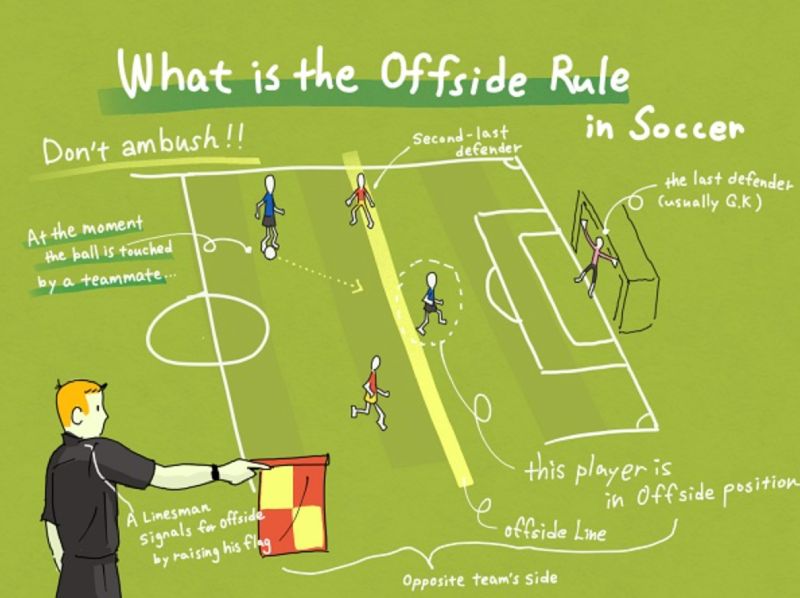The term “offside” refers to when a defensive player crosses the line of scrimmage before the ball snaps. Offsides violations result in five free yards, which can lead to an automatic first down. What you need to know about offsides in American football.
Table of Contents
How Many Penalty Yards is an Offsides Violation?
Offsides violations give the offensive team a 5-yard penalty if the defense moves too early. Before the snap, both sides must remain on their side of the line of scrimmage.
False starts result in a 5-yard penalty the other way if the offensive line moves before snapping. NFL, college football, and high school football all have this 5-yard penalty.

Are Offsides an Automatic First Down in American Football?
Offside rules state that the offense receives five yards automatically. The offense now gets an automatic first down if the defense creates an offside penalty on third and four.
Due to the fact that these five yards will make a first down, the offense receives an automatic first down.
What Happens if there are Offsides on a Field Goal Attempt?
When the offense attempts a field goal kick and the defense is offsides, a few things happen. If the kicker makes the field goal attempt, the offense can keep those three points. If the kicker misses the field goal attempt, he or she can move up five yards and attempt it again.
A five-yard gain creates a new set of downs, so the offense can come back out and the special teams can go back to the sidelines.
What Happens if there are Offsides on a Punt Attempt?
Offsides during a punt attempt result in a few things. The kicker can keep the placement of the kick if it is a good kick. The kicking team can, however, re-do the kick and move up five yards.
The offense comes out if it moves up five yards for a first down, and the special teams return to the sidelines.
What Happens if the Defense is Offsides Close to the Goal Line?
The offense can move the ball half the distance to the end zone if the defense creates an offside penalty close to the goal line.
Can a Defense Keep Getting Offsides to Stop the Offense from Scoring a Touchdown?
Referees can enact rulebook 12.3.2 if the defense keeps creating offside penalties to stop the offense from scoring.
According to this rule, the referee must warn the defense to stop making offside penalties. A touchdown is awarded to the offense team if the defense ignores this warning.
Why Do Some Teams Get Offsides?
Offside penalties may be assessed to defensive teams if the quarterback runs a hard count. To get the best jump against the offense, defensive players time up when the passer receives the ball.
There are times, however, when the quarterback changes his hike call and either asks for the ball earlier or much later than expected by the defensive team. The change in count might cause a defender to move too early, resulting in an offside.
Blitzing is another reason defensive teams get offsides. Linebackers who blitz look for gaps in the opponent’s formation via the pre-snap. In some cases, a player might break the line of scrimmage to time up their blitz perfectly, but that can backfire and result in a five-yard penalty. Nevertheless, timing a blitz perfectly could mean the difference between sacking the quarterback and not.
How Does the Referee Signal Offsides?
In the case of defensive offsides, a referee will throw up their penalty flag to indicate the call. Putting the flag up in the air does not delay the game, but it gives the offense a free play.
Why is Offsides Referred to as a Free Play for the Offense?
When a defensive player moves past the line of scrimmage and the referee signals the penalty, QB’s often throw a Hail Mary pass since there is no downside to the play. When a wide receiver catches a Hail Mary pass, the offense can decline the penalty and move to their new position.
Interceptions will not count because the opposing team made the penalty, and incomplete passes will still result in penalties of five yards. While an offsides penalty is in effect, the offense can do whatever they want.
What about Neutral Zone Infractions?
In American Football, neutral zone infractions are similar to offside penalties. The main difference is that a defensive player might enter the neutral zone, causing the offensive player to react and move. After the whistle is blown, the referee will signal the neutral zone infraction.
If the offensive player does not respond, however, the play continues without penalty, and the defender can leave the neutral zone before the snap.
There is a 5-yard penalty for a neutral zone infraction, but the referee will call the play dead before the snap. Neutral zone infractions stop the action immediately, unlike offsides penalties, which can result in big yards for the offensive team.
What about Encroachment on the Defense?
A defensive lineman encroaching on an offensive lineman is known as encroachment. Another example of an encroachment is when a defender contacts the football before the snap.
As a result of an encroachment penalty, the play will be over and the offensive team will be awarded five yards.
What is the Difference Between a False Start and Offsides in the NFL?
False starts occur when the offensive line makes an illegal motion before snapping the ball. A player on the offensive line might move back to anticipate a player blitzing before the ball snaps, for instance. The offense must move the ball five yards back from its original location if that is the case.
Defenses, on the other hand, commit offsides. The offense gets five yards automatically if a defender passes the line of scrimmage before the ball snaps.
Conclusion: What Does Offsides Mean in the NFL?
To summarize, offsides in the NFL refers to a defensive player crossing the line of scrimmage before the snap. Offsides create a free play for the offense because they get five free yards. During a football game, if the offsides penalty automatically creates a first down for the offensive team, it can dramatically shift momentum.
